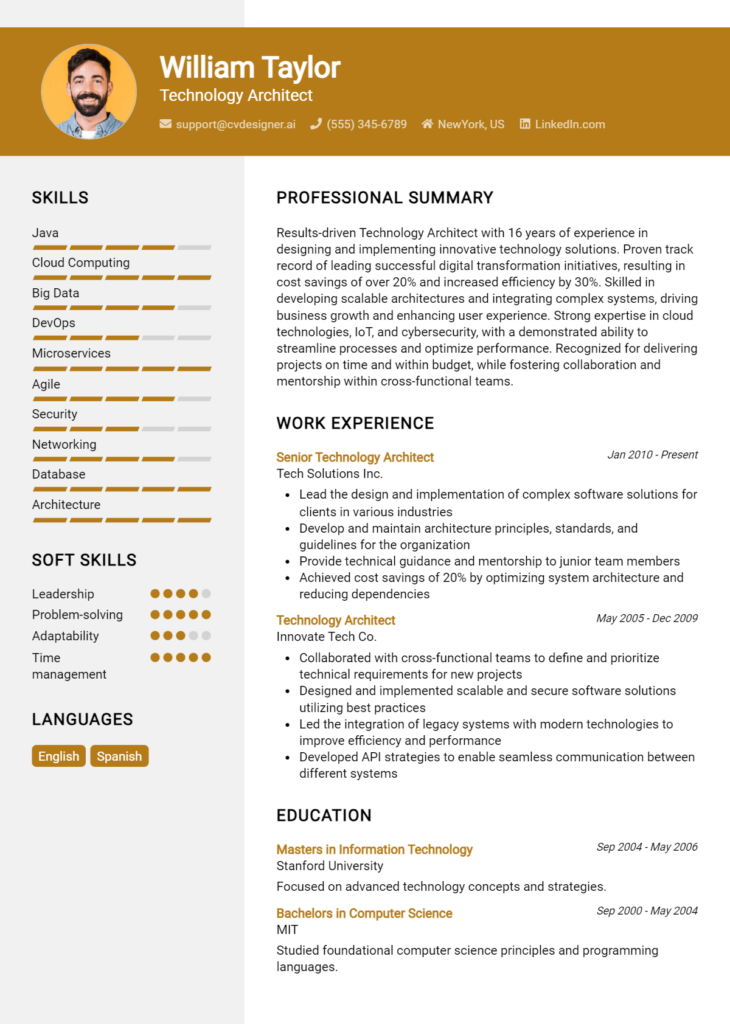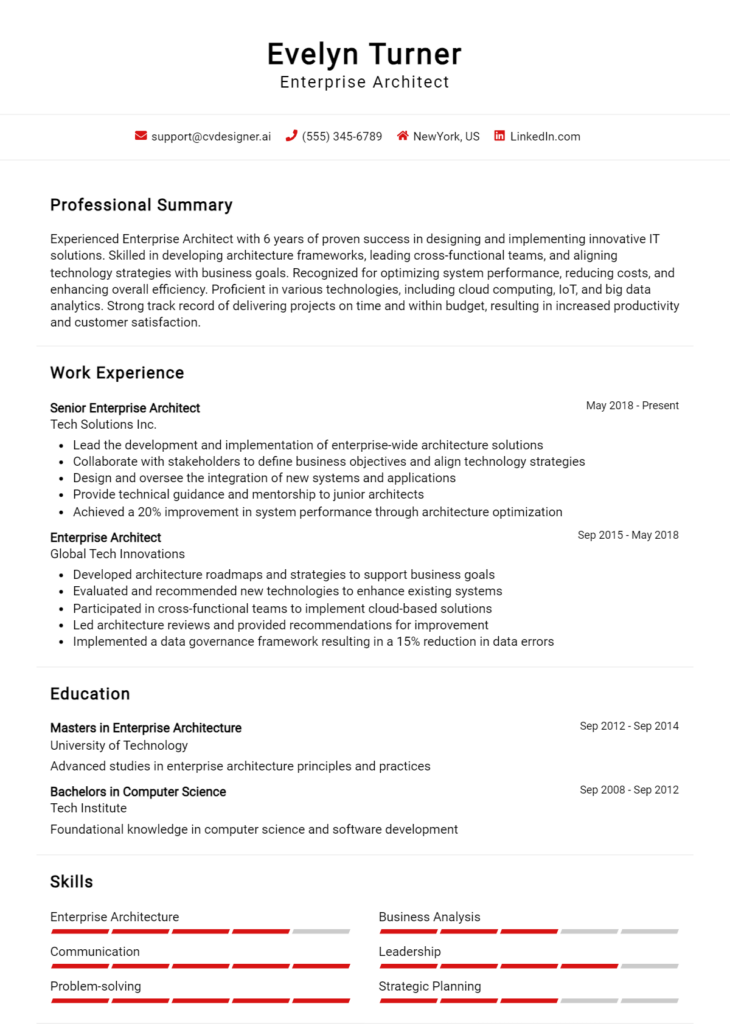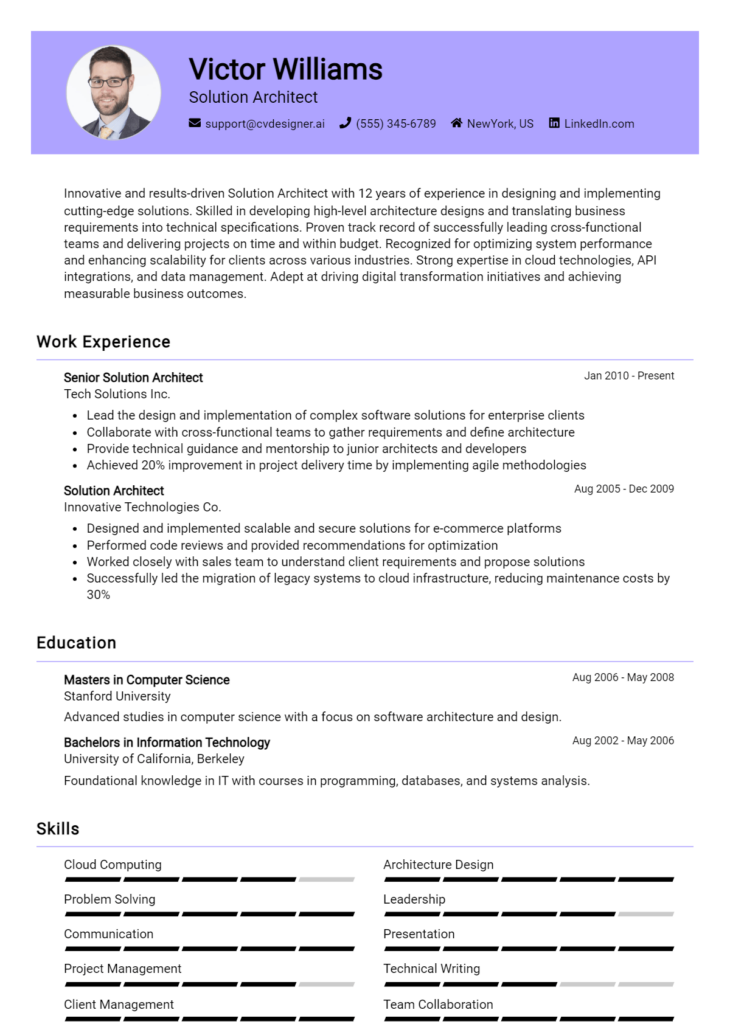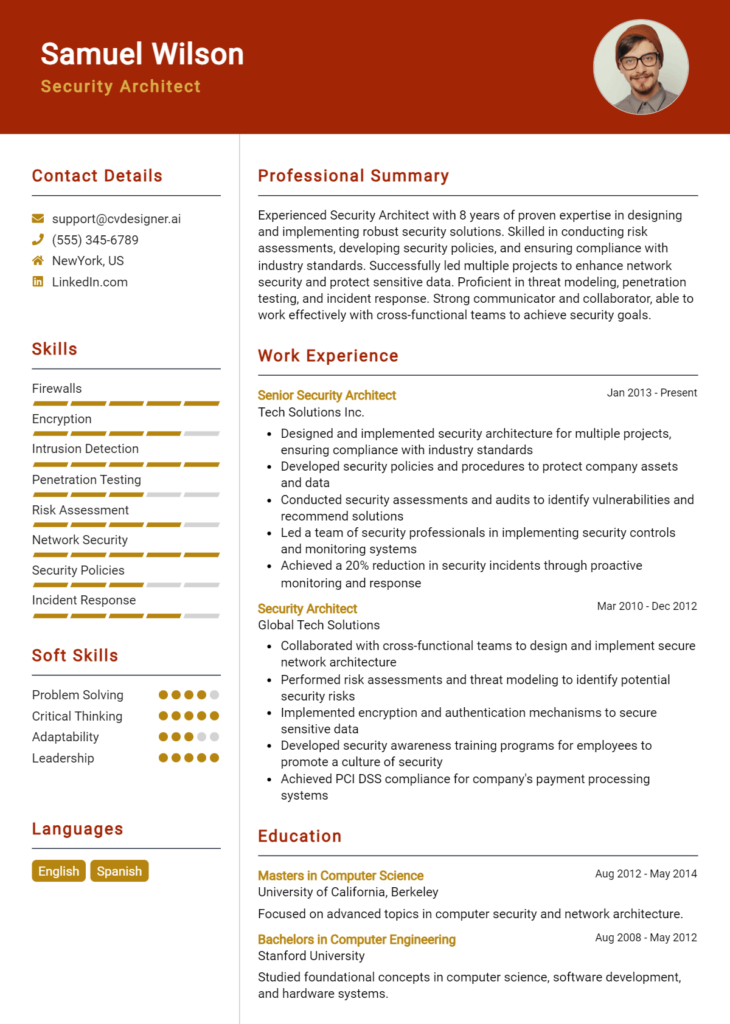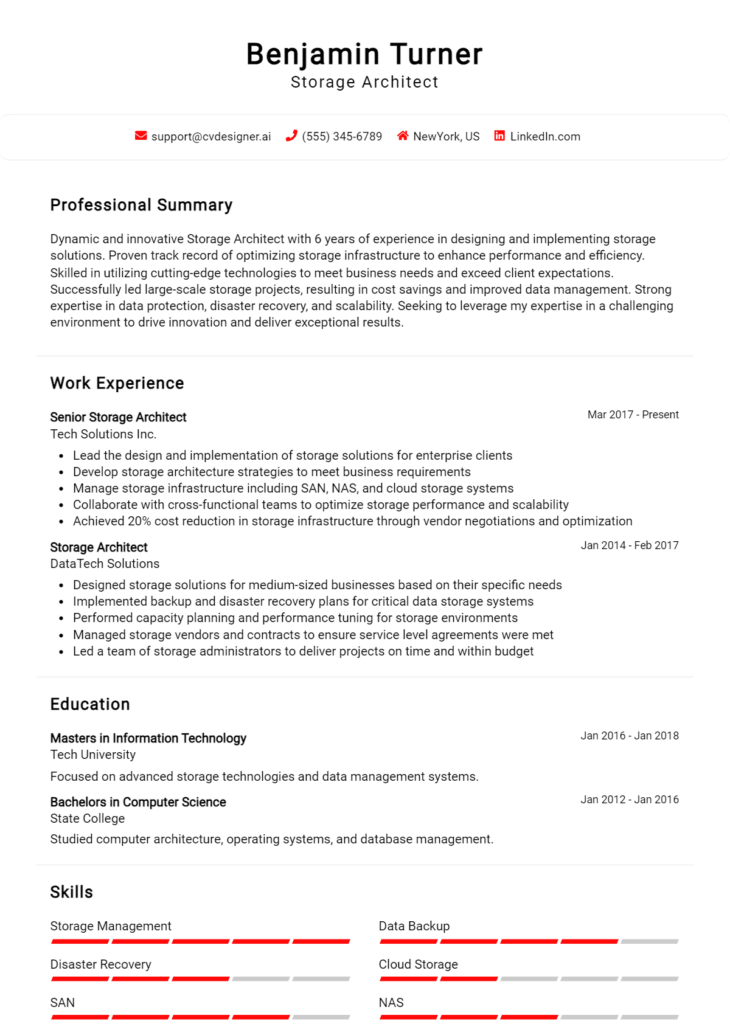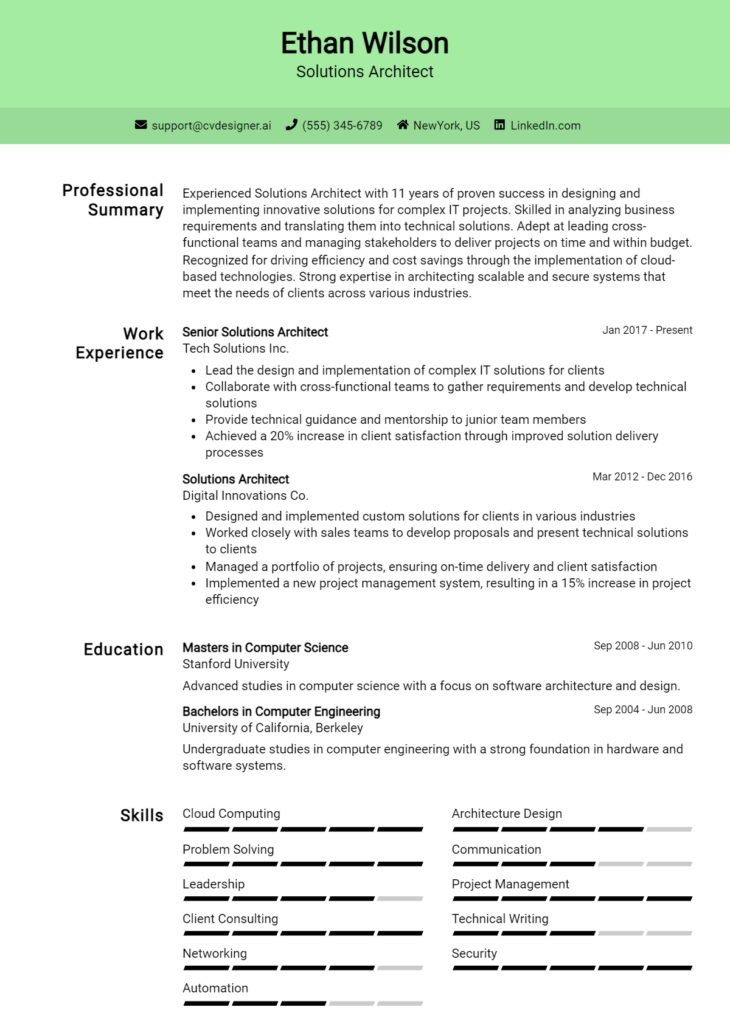Most Popular Information Architect Resume Examples
Explore additional Information Architect resume samples and guides and see what works for your level of experience or role.
As the digital landscape continues to evolve, the role of an Information Architect has emerged as a cornerstone in creating effective and user-friendly digital experiences. Information Architects are tasked with organizing, structuring, and labeling content in a way that enhances usability and accessibility, making their expertise invaluable in a world overflowing with information. A well-crafted resume is essential for aspiring Information Architects, as it serves as a powerful tool to showcase their skills, experiences, and understanding of user-centered design principles. A compelling resume can be the difference between landing an interview and getting lost in the shuffle of applicants, making it crucial to invest time and effort into its creation.
In this comprehensive guide to writing an Information Architect resume, we'll cover essential aspects that will help you stand out in a competitive job market. We will delve into the key responsibilities and skills required for this role, discuss the best formats to utilize for your resume, and identify common mistakes to avoid that could hinder your chances of success. Additionally, we will provide resume examples suitable for all experience levels, offer practical tips on crafting an impactful resume, and guide you in selecting the right resume templates to enhance your presentation. Whether you’re just starting in your career or looking to advance to a senior position, this guide will equip you with the insights needed to create an outstanding resume that captures the attention of employers.
Key Responsibilities and Skills for a Information Architect
Information Architects play a crucial role in designing and organizing information systems, ensuring that users can easily access and navigate content. Their primary responsibilities include analyzing user needs, developing information structures, and creating wireframes and prototypes to facilitate effective user experiences. An Information Architect must also collaborate with cross-functional teams to ensure that content is aligned with business objectives and user expectations.
Key Responsibilities:
- Conduct user research to understand needs and behaviors.
- Develop site maps, wireframes, and prototypes to visualize information structures.
- Create and maintain documentation for information architecture principles.
- Collaborate with UX designers, developers, and stakeholders to implement solutions.
- Perform usability testing to refine and enhance the user experience.
- Stay updated on industry trends and best practices in information architecture.
Essential Skills:
- Proficiency in wireframing and prototyping tools (e.g., Sketch, Axure, Figma).
- Strong understanding of user-centered design principles.
- Excellent analytical and problem-solving skills.
- Familiarity with information retrieval and taxonomy development.
- Good communication and collaboration skills.
- Experience with usability testing and user research methodologies.
Highlighting these skills effectively in the resume skills section is vital, as it allows potential employers to quickly assess your fit for the role. Tailoring these responsibilities and skills to align with the specific job description enhances your chances of making a strong impression. Consider how these skills can be showcased in your CV to demonstrate your qualifications and relevance for the position, making it easier for you to stand out in a competitive job market.
Best Resume Format and Structure for a Information Architect
When crafting a resume for an Information Architect position, it’s crucial to choose a format that highlights your skills, experience, and qualifications effectively. Below is a detailed guide on the best resume format and structure for an Information Architect, including key sections to include and tips to enhance your application.
Contact Information
At the top of your resume, include your contact information. This should consist of:
- Full Name
- Phone Number
- Professional Email Address
- LinkedIn Profile (optional)
- Portfolio Website (if applicable)
Professional Summary
Following your contact information, write a professional summary. This section should be 2-4 sentences long and provide a snapshot of your career. Focus on your years of experience, key skills, and what you bring to the role. Tailor this summary to reflect the specific job you are applying for by incorporating keywords from the job description.
Work Experience
In the work experience section, list your professional history in reverse chronological order. Each entry should include:
- Job Title
- Company Name
- Location (City, State)
- Dates of Employment (Month/Year format)
- Bullet points detailing your responsibilities and achievements
Focus on quantifiable achievements and specific projects relevant to information architecture, such as:
- Designing user-centered information systems
- Conducting user research and usability testing
- Developing wireframes and prototypes
- Collaborating with cross-functional teams
Education
In the education section, include your highest degree first. Provide the following details:
- Degree Title (e.g., Bachelor of Arts in Information Science)
- Institution Name
- Graduation Date (Month/Year)
If you have relevant certifications or coursework, consider including them here or in a separate section.
Skills
This section should include both hard and soft skills relevant to an Information Architect role. Examples include:
- Information architecture principles
- Wireframing and prototyping tools (e.g., Axure, Balsamiq)
- User experience (UX) design
- Data modeling
- Content strategy
- Strong analytical and communication skills
Tailor the skills to match those mentioned in the job description to ensure alignment with what the employer is seeking.
Certifications
If you hold any relevant certifications, such as Certified Professional in Information Architecture (CPIA) or certifications in UX/UI design, list them in this section. Include the certification title, issuing organization, and the date obtained.
Additional Tips
- Format: Use a clean, professional layout with consistent font styles and sizes. A combination or chronological format is often effective for this role, as it allows you to showcase both your work history and skills prominently.
- Length: Keep your resume to one or two pages, ensuring it's concise and focused.
- Keywords: Incorporate keywords from the job description to optimize your resume for Applicant Tracking Systems (ATS).
The format of your resume complements the cover letter by providing a cohesive presentation of your qualifications. In your cover letter, you can expand on specific experiences highlighted in your resume, demonstrating how your background aligns with the needs of the organization. Use a similar tone and language in both documents to present a unified professional image.
By following this structured approach, your resume will not only be visually appealing but also effectively communicate your qualifications for the Information Architect role.
Writing Tips and Best Practices for a Information Architect Resume
When crafting a resume as an Information Architect, it's essential to showcase your skills and experiences in a clear, concise manner that aligns with the expectations of the role. Focus on presenting a structured format that highlights your key competencies, such as user experience design, data modeling, and information systems management. Utilize resume writing tips to ensure your document has a professional appearance and effectively communicates your qualifications. Keep in mind that these practices can also enhance the quality of your cover letter.
- Use action verbs to begin bullet points, such as "developed," "designed," or "implemented," to convey your proactive contributions.
- Quantify your achievements whenever possible, for example, "Improved information retrieval time by 30% through the redesign of the database structure."
- Incorporate industry-specific keywords related to Information Architecture, such as "taxonomy," "wireframes," "user journeys," and "content management systems," to pass through applicant tracking systems.
- Tailor your resume for each job application by aligning your skills and experiences with the specific requirements mentioned in the job description.
- Keep your resume to one or two pages, focusing on relevant experience and skills that are directly applicable to the role of an Information Architect.
- Highlight collaborative projects and teamwork, as Information Architects often work closely with UX designers, developers, and stakeholders.
- Include certifications or professional development courses related to Information Architecture or related fields to demonstrate your commitment to ongoing learning and expertise.
Common Mistakes to Avoid in a Information Architect Resume
When crafting a resume for an Information Architect position, it's crucial to present your skills and experiences in a clear and compelling manner. However, many candidates make common mistakes that can undermine their chances of landing an interview. To ensure your resume stands out for the right reasons, be mindful of these pitfalls:
- Overloading the resume with excessive information, making it difficult to read.
- Using generic descriptions that fail to highlight unique skills and accomplishments.
- Neglecting to tailor the resume to the specific job description and requirements.
- Failing to include relevant keywords that align with the job posting.
- Listing responsibilities instead of focusing on achievements and measurable outcomes.
- Ignoring formatting best practices, resulting in a cluttered or unprofessional appearance.
- Including outdated or irrelevant experience that does not pertain to the Information Architect role.
- Making spelling and grammatical errors that can detract from professionalism.
- Not showcasing a portfolio or examples of past work that demonstrate design and organizational skills.
- Overlooking the importance of a compelling summary or objective statement that captures attention.
To avoid these errors, consider reviewing the common mistakes to avoid in a resume. Additionally, it's important to pay attention to your cover letter as well; be sure to check out the common cover letter mistakes that should also be avoided to enhance your overall application.
Sample Information Architect Resumes
As the demand for organized and accessible information continues to grow, the role of an Information Architect becomes increasingly vital across various industries. An effective Information Architect not only structures data but also enhances the user experience by ensuring that information is easily navigable and user-friendly. Below are three sample resumes tailored for an Information Architect position, catering to diverse experience levels and career paths.
Sample Resume: Experienced Information Architect
John Smith
[City, State]
[Phone Number]
[Email Address]
Professional Summary
Results-driven Information Architect with over 10 years of experience in designing and implementing user-centered information systems. Proven ability to enhance user experience and streamline information retrieval through innovative design solutions. Expertise in conducting user research, creating wireframes, and collaborating with cross-functional teams.
Skills
- Information Architecture
- User Experience Design
- Wireframing and Prototyping
- User Research and Usability Testing
- Content Management Systems (CMS)
- HTML/CSS
- Project Management
Professional Experience
Senior Information Architect
XYZ Corporation, City, State
January 2018 - Present
- Led the redesign of the corporate website, improving user engagement by 40% through improved navigation and accessibility.
- Conducted user research to identify pain points, resulting in actionable insights that informed design decisions.
- Collaborated with developers and designers to create wireframes and prototypes for new features.
Information Architect
ABC Solutions, City, State
June 2012 - December 2017
- Developed information architecture for multiple web-based applications, enhancing usability and information retrieval.
- Implemented usability testing procedures that increased user satisfaction scores by 25%.
- Provided training and support for content contributors on best practices for information organization.
Education
Bachelor of Science in Information Science
University of State, City, State
Graduated: May 2012
Sample Resume: Entry-Level Information Architect
Emily Johnson
[City, State]
[Phone Number]
[Email Address]
Professional Summary
Detail-oriented graduate with a Bachelor’s degree in Information Science and a passion for user-centered design. Proficient in creating user-friendly interfaces and engaging information architectures. Eager to contribute to a dynamic team and enhance the digital experience for users.
Skills
- Information Architecture Fundamentals
- User Experience Research
- Wireframing Tools (e.g., Balsamiq, Sketch)
- Basic HTML/CSS
- Analytical Skills
- Team Collaboration
Education
Bachelor of Science in Information Science
University of State, City, State
Graduated: May 2023
Internship Experience
Information Architecture Intern
Digital Innovations, City, State
June 2022 - August 2022
- Assisted in the development of the information architecture for a new e-commerce platform.
- Conducted usability testing and gathered user feedback to refine navigation structures.
- Collaborated with senior architects to create wireframes and user flow diagrams.
Projects
- Website Redesign Project: Developed a comprehensive information architecture for a non-profit website as part of a capstone project, resulting in improved user navigation and accessibility.
- User Research Study: Conducted a study on user behaviors and preferences that informed the redesign of a mobile app interface.
Sample Resume: Career Changer to Information Architect
Michael Brown
[City, State]
[Phone Number]
[Email Address]
Professional Summary
Dynamic professional with over 8 years of experience in project management and a strong passion for information architecture. Proven track record of leading teams and projects to success. Seeking to leverage analytical skills and project management experience to transition into an Information Architect role.
Skills
- Project Management
- User-Centered Design Principles
- Wireframing and Prototyping
- Data Analysis
- Communication and Collaboration
- Change Management
Professional Experience
Project Manager
Tech Innovations, City, State
March 2015 - Present
- Managed cross-functional teams to deliver complex projects on time and within scope, enhancing stakeholder satisfaction.
- Developed and implemented project plans, timelines, and budgets while ensuring alignment with user needs and business objectives.
- Conducted stakeholder interviews to gather requirements and inform project design.
Project Coordinator
Creative Solutions, City, State
January 2013 - February 2015
- Assisted in project planning and execution, focusing on user experience improvements for web-based applications.
- Facilitated communication between design and development teams to ensure project goals were met.
Education
Bachelor of Arts in Business Administration
University of State, City, State
Graduated: May 2012
For more inspiration, explore various resume templates tailored to your unique qualifications. Additionally, consider pairing your resume with corresponding cover letter examples to create a complete job application package that stands out to potential employers.
Checklist for a Information Architect Resume
- Proofread for Errors: Carefully read through your resume to catch any spelling, grammar, or punctuation mistakes that could undermine your professionalism.
- Check Consistency: Ensure that the formatting, font style, and size are consistent throughout the document, including headings, bullet points, and spacing.
- Tailor to the Job Description: Customize your resume for the specific Information Architect position by highlighting relevant skills, experiences, and keywords from the job posting.
- Highlight Key Skills: Clearly showcase technical and soft skills that are essential for an Information Architect, such as data modeling, user experience design, and project management.
- Quantify Achievements: Whenever possible, use numbers and metrics to illustrate your accomplishments and impact in previous roles.
- Include Relevant Experience: Focus on including experience that relates directly to the responsibilities and requirements of the Information Architect role.
- Keep it Concise: Aim for a one-page resume if possible, ensuring every word adds value and avoids unnecessary filler content.
- Utilize a Clear Structure: Organize your resume with distinct sections (e.g., Summary, Skills, Experience, Education) to enhance readability and flow.
- Consider an AI Resume Builder: Use an AI resume builder to help you format and organize your resume effectively, ensuring all elements are well-presented.
- Adapt for Other Documents: Remember that a similar checklist can be applied to creating a CV or cover letter to maintain professionalism across all your job application materials.
Key Takeaways for a Information Architect Resume Guide
Crafting a strong resume as an Information Architect requires attention to detail and a clear presentation of your skills and experiences. By utilizing the examples and tips provided in this guide, you can create a resume that effectively showcases your qualifications and stands out to potential employers. We encourage you to take the next step by downloading a customizable template from our resume templates collection or exploring our cover letter templates to complement your application. Additionally, consider using our user-friendly resume maker to streamline the creation process. Remember, adhering to similar guidelines will also enhance your CV and cover letter, making them compelling tools in your job search. For more insights on crafting an impressive CV, check out our CV templates and for guidance on writing an effective cover letter, visit our resource on how to write a cover letter. Your journey to becoming a standout candidate starts here!

